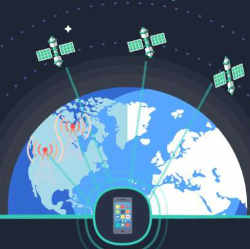
Satellite phones and other devices that provide a direct link between a handheld device and a satellite are not new to the market, but they typically are expensive, single-function devices that are not targeted at a general consumer audience. However, in 2022, two services were launched that allow consumer-oriented smartphones to connect with satellites to send messages to emergency services.
Apple's Emergency SOS via Satellite service on the iPhone 14 permits you to send messages to emergency services in the U.S., Canada, U.K., Ireland, France, and Germany, while Huawei offers a similar service to its customers in China via its Mate 50 series devices.
To provide emergency messaging services, Apple has partnered with Globalstar, a U.S. satellite communication company with 24 low Earth orbit (LEO) satellites. The service is offered for free for two years to Apple iPhone users.
Users of the Huawei Mate 50 series will be able to send short text messages and utilize navigation services via China's BeiDou satellite network.
Approval for smartphone-to-satellite communications has been granted by 3GPP, the international organization that oversees standards development for communications technologies for 5G non-terrestrial networks. As such, other organizations also are seeking to develop and offer consumer-oriented satellite communication services.
T-Mobile and SpaceX's Starlink announced in August 2022 that they had formed a technical partnership to connect T-Mobile subscribers outside of cellular coverage areas using Starlink's satellites, initially focusing on SMS messaging and with a goal of scaling to offer more comprehensive voice and data services. Similarly, AST SpaceMobile in May 2022 was granted an experimental license to test its BlueWalker 3 satellite; it appeared to be using spectrum licenses owned by AT&T. Other solutions, such as Motorola's Defy Satellite Link, a Bluetooth dongle that will connect to a smartphone (Apple or Android) to provide messaging and SOS functions, will be available in Q2 2023.
Qualcomm and Iridium announced a partnership early this year called Snapdragon Satellite, aimed at Android phone users. The service will support two-way messaging (compared with Apple's one-way, handset-to-emergency responder) services using Iridium's L-band satellite spectrum for both the uplink and downlink. Whereas the Iridium Connected Garmin InReach and Iridium GO! devices and services are targeted at users who seek full-function, dedicated satellite communication connectivity, Snapdragon Satellite is targeted at the casual user who may only require connectivity in emergencies. "It's for people who didn't have a plan to go outside of coverage, but they did and now they realize they can communicate, whereas inReach, for example is a very specific, highly durable, highly ruggedized, high-performance, prosumer, hiker, biker, [and] camper-focused product," says Joel Thompson, Iridium's vice president, Global Product and Service Management.
Snapdragon Satellite will first be available to smartphones that use Qualcomm's Snapdragon 8 Gen 2 mobile platform, which will connect to satellite services via the Snapdragon 5G modem. The first Android devices featuring Snapdragon Satellite are expected to be available in the second half of this year, with Qualcomm announcing OEM partnerships with Honor, Motorola, Nothing, OPPO, vivo and Xiaomi. According to a Qualcomm spokesperson, the cost of the satellite-based messaging service and dependent services will depend on OEMs and service providers, and how they choose to offer the service.
While some organizations are utilizing existing satellites to provide satellite connectivity, Lynk Global Inc., a direct-to-satellite company, is building out its own network of satellites designed to support broadband connectivity. The company is partnering with mobile network operators (MNOs) to connect users with a network that is planned to encompass 5,000 satellites operating in LEO. Charles Miller, co-founder and CEO of Lynk, says the company has 27 contracts with service providers that will be able to provide connectivity in areas where it's economically or geographically unfeasible to build out terrestrial cellular networks.
While Miller says that Lynk's planned network of satellites in orbit will provide continuous, real-time broadband-level service, just 150 satellites are required to provide seamless messaging, and a network of 6 to 12 satellites is available now to provide limited functionality. "As we're ramping up, we have the 27 MNOs we've signed to contracts today, and they want to start providing services even with less-than-global seamless messaging," Miller says. "Because where you have nothing, something is infinitely better than nothing, and so they say, 'hey, we will sell the service with six or 12 satellites'."
The biggest challenge, according to Miller, is not the technology; "We've proven all the tech; it's now about scaling." While Lynk says it is partnering with SpaceX to provide launch vehicles to put satellites in orbit, it's still a major capital lift to fund and produce satellites for a service that, to date, is very much a niche.
"From a business perspective, I don't believe that satellite in a smartphone is a [standalone] business," Iridium's Thompson says, noting that Iridium's predessor went bankrupt after launching its first satellite constellation, due to the immense capital expenditures involved, along with the long time horizon for investors to receive payback. "When you look at some of the MNO-reliant players, for example, they have to create their own satellite networks, do all the regulatory work, build a back office, and create support, which requires $3 billionor $4 billion. I do not believe this market can sustain that."
Keith Kirkpatrick is Principal, 4K Research & Consulting, LLC, based in New York, NY.



Join the Discussion (0)
Become a Member or Sign In to Post a Comment